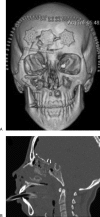Nasoseptal flap closure of traumatic cerebrospinal fluid leaks
- PMID: 22451808
- PMCID: PMC3312593
- DOI: 10.1055/s-0030-1266763
Nasoseptal flap closure of traumatic cerebrospinal fluid leaks
Abstract
The vascularized nasoseptal flap has become a principal reconstructive technique for the closure of endonasal skull base surgery defects. Despite its potential utility, there has been no report describing the use of the modern nasoseptal flap to repair traumatic cerebrospinal fluid (CSF) leaks and documenting the outcomes of this application. Specific concerns in skull base trauma include septal trauma with disruption of the flap pedicle, multiple leak sites, and issues surrounding persistent leaks after traumatic craniotomy. We performed a retrospective case series review of 14 patients who underwent nasoseptal flap closure of traumatic CSF leaks in a tertiary academic hospital. Main outcome measures include analysis of clinical outcome data. Defect etiology was motor vehicle collision in eight patients (57%), prior sinus surgery in four (29%), and assault in two (14%). At the time of nasoseptal flap repair, four patients had failed prior avascular grafts and two had previously undergone craniotomies for repair. Follow-up data were available for all patients (mean, 10 months). The overall success rate was 100% (no leaks), with 100% defect coverage. The nasoseptal flap is a versatile and reliable local reconstructive technique for ventral base traumatic defects, with a 100% CSF leak repair rate in this series.
Keywords: Cranial base; cerebrospinal fluid leak; endoscopy; nasoseptal flap; reconstructive techniques.
Figures


Similar articles
-
Utilization of the Nasoseptal Flap for Repair of Cerebrospinal Fluid Leak after Endoscopic Endonasal Approach for Resection of Pituitary Tumors.Brain Tumor Res Treat. 2019 Apr;7(1):10-15. doi: 10.14791/btrt.2019.7.e19. Brain Tumor Res Treat. 2019. PMID: 31062526 Free PMC article.
-
The Endonasal Endoscopic Management of Cerebrospinal Fluid Rhinorrhea.Cureus. 2021 Feb 20;13(2):e13457. doi: 10.7759/cureus.13457. Cureus. 2021. PMID: 33777546 Free PMC article.
-
Endoscopic Endonasal Repair of Spontaneous Cerebrospinal Fluid Leaks Using Multilayer Composite Graft and Vascularized Pedicled Nasoseptal Flap Technique.Allergy Rhinol (Providence). 2019 Nov 13;10:2152656719888622. doi: 10.1177/2152656719888622. eCollection 2019 Jan-Dec. Allergy Rhinol (Providence). 2019. PMID: 31763054 Free PMC article.
-
Cranial base repair with combined vascularized nasal septal flap and autologous tissue graft following expanded endonasal endoscopic neurosurgery.J Neurol Surg A Cent Eur Neurosurg. 2013 Mar;74(2):101-8. doi: 10.1055/s-0032-1330118. Epub 2013 Jan 14. J Neurol Surg A Cent Eur Neurosurg. 2013. PMID: 23319331 Review.
-
Nasoseptal Flap for Skull Base Reconstruction in Children.J Neurol Surg B Skull Base. 2018 Feb;79(1):37-41. doi: 10.1055/s-0037-1617435. Epub 2018 Jan 11. J Neurol Surg B Skull Base. 2018. PMID: 29404239 Free PMC article. Review.
Cited by
-
Multidisciplinary Approach for the Management of a Case With Craniofacial Penetrating Injury Compressing the Internal Carotid Artery.Cureus. 2023 Apr 9;15(4):e37340. doi: 10.7759/cureus.37340. eCollection 2023 Apr. Cureus. 2023. PMID: 37041854 Free PMC article.
-
Complications of Skull Base Surgery.Semin Plast Surg. 2017 Nov;31(4):227-230. doi: 10.1055/s-0037-1607203. Epub 2017 Oct 25. Semin Plast Surg. 2017. PMID: 29075162 Free PMC article. Review.
-
Comprehensive review on rhino-neurosurgery.GMS Curr Top Otorhinolaryngol Head Neck Surg. 2015 Dec 22;14:Doc01. doi: 10.3205/cto000116. eCollection 2015. GMS Curr Top Otorhinolaryngol Head Neck Surg. 2015. PMID: 26770276 Free PMC article. Review.
-
The Role of Advanced Endoscopic Resection of Diverse Skull Base Malignancies: Technological Analysis during an 8-Year Single Institutional Experience.J Neurol Surg B Skull Base. 2020 Aug 5;82(4):417-424. doi: 10.1055/s-0040-1714115. eCollection 2021 Aug. J Neurol Surg B Skull Base. 2020. PMID: 35573925 Free PMC article.
-
The reconstruction of skull base defects in infants using pedicled nasoseptal flap-a review of four cases.Childs Nerv Syst. 2019 Nov;35(11):2157-2162. doi: 10.1007/s00381-019-04132-0. Epub 2019 Apr 9. Childs Nerv Syst. 2019. PMID: 30968177
References
-
- Costa H, Cerejo A, Baptista A, et al. The galea frontalis myofascial flap in anterior fossa CSF leaks. Br J Plast Surg. 1993;46:503–507. - PubMed
-
- Platt M P, Parnes S M. Management of unexpected cerebrospinal fluid leak during endoscopic sinus surgery. Curr Opin Otolaryngol Head Neck Surg. 2009;17:28–32. - PubMed
-
- Moyer J S, Chepeha D B, Teknos T N. Contemporary skull base reconstruction. Curr Opin Otolaryngol Head Neck Surg. 2004;12:294–299. - PubMed
-
- Hadad G, Bassagasteguy L, Carrau R L, et al. A novel reconstructive technique after endoscopic expanded endonasal approaches: vascular pedicle nasoseptal flap. Laryngoscope. 2006;116:1882–1886. - PubMed
-
- Zanation A M, Carrau R L, Snyderman C H, et al. Nasoseptal flap reconstruction of high flow intraoperative cerebral spinal fluid leaks during endoscopic skull base surgery. Am J Rhinol Allergy. 2009;23:518–521. - PubMed

